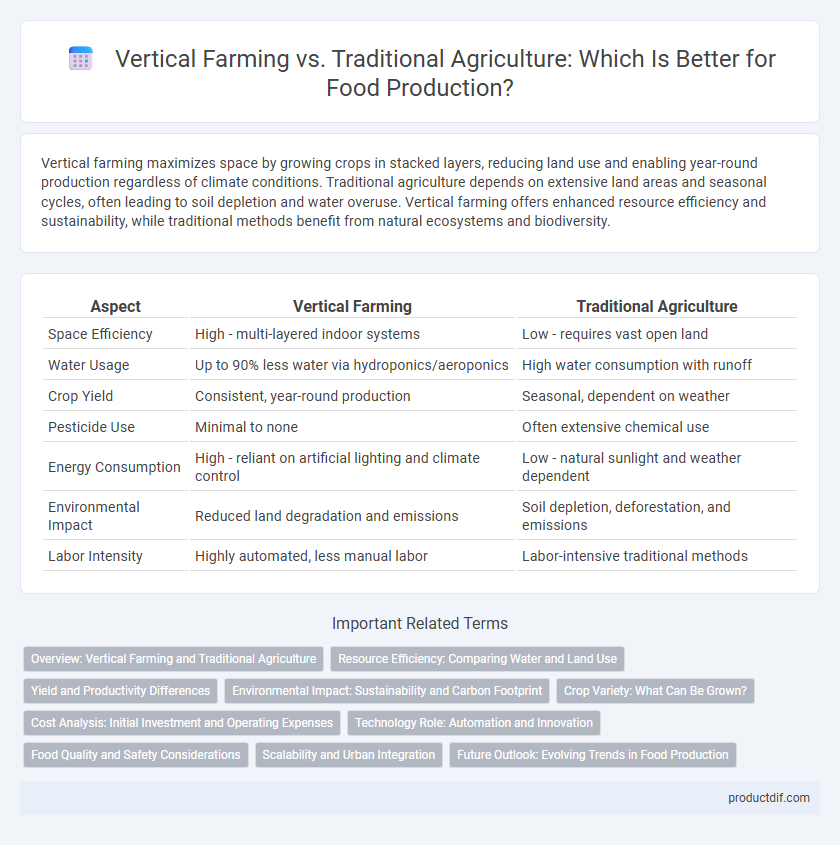Vertical farming maximizes space by growing crops in stacked layers, reducing land use and enabling year-round production regardless of climate conditions. Traditional agriculture depends on extensive land areas and seasonal cycles, often leading to soil depletion and water overuse. Vertical farming offers enhanced resource efficiency and sustainability, while traditional methods benefit from natural ecosystems and biodiversity.
Table of Comparison
| Aspect | Vertical Farming | Traditional Agriculture |
|---|---|---|
| Space Efficiency | High - multi-layered indoor systems | Low - requires vast open land |
| Water Usage | Up to 90% less water via hydroponics/aeroponics | High water consumption with runoff |
| Crop Yield | Consistent, year-round production | Seasonal, dependent on weather |
| Pesticide Use | Minimal to none | Often extensive chemical use |
| Energy Consumption | High - reliant on artificial lighting and climate control | Low - natural sunlight and weather dependent |
| Environmental Impact | Reduced land degradation and emissions | Soil depletion, deforestation, and emissions |
| Labor Intensity | Highly automated, less manual labor | Labor-intensive traditional methods |
Overview: Vertical Farming and Traditional Agriculture
Vertical farming utilizes controlled indoor environments to grow crops in stacked layers, optimizing space and resource efficiency while minimizing water use and pesticide reliance. Traditional agriculture relies on large open fields, dependent on seasonal weather, soil quality, and substantial land area for crop production. Vertical farming offers higher yields per square foot and year-round harvests, whereas traditional methods benefit from established infrastructure and biodiversity support.
Resource Efficiency: Comparing Water and Land Use
Vertical farming uses up to 95% less water than traditional agriculture by recycling and precisely controlling irrigation, drastically reducing water waste. It requires significantly less land, often producing crops in urban environments on stacked layers, thereby conserving arable land for other uses. Traditional agriculture depends heavily on extensive land and irrigation, leading to higher water consumption and soil depletion compared to resource-efficient vertical farming systems.
Yield and Productivity Differences
Vertical farming achieves significantly higher yields per square foot compared to traditional agriculture by utilizing stacked layers and controlled environments that optimize plant growth conditions year-round. Controlled LED lighting, precise nutrient delivery, and climate regulation enable crops to grow faster and with fewer resources, boosting productivity by up to 10 times. Traditional agriculture faces limitations from weather variability, soil quality, and seasonal constraints, resulting in lower and less predictable yields.
Environmental Impact: Sustainability and Carbon Footprint
Vertical farming significantly reduces environmental impact by using up to 95% less water and eliminating the need for pesticides compared to traditional agriculture. This method halves the carbon footprint by minimizing land use, reducing transportation emissions through urban location, and optimizing energy consumption with controlled environments. Traditional farming, reliant on large-scale land and resource use, contributes substantially to deforestation, soil degradation, and greenhouse gas emissions.
Crop Variety: What Can Be Grown?
Vertical farming enables the cultivation of diverse leafy greens, herbs, and some fruiting plants year-round due to controlled environments, while traditional agriculture supports a wider variety of crops including grains, root vegetables, and large-scale fruit production dependent on seasonal cycles. The limited space and specific environmental conditions in vertical farms restrict the growth of tall or deep-rooted crops, whereas traditional fields offer extensive land for a broader crop range. Advances in vertical farming technology are gradually expanding the types of crops feasible for indoor growth, but traditional agriculture remains essential for bulk and staple foods.
Cost Analysis: Initial Investment and Operating Expenses
Vertical farming requires a significantly higher initial investment due to advanced technologies such as LED lighting, climate control systems, and automated irrigation, compared to traditional agriculture's reliance on natural resources. Operating expenses in vertical farming include electricity, maintenance of high-tech equipment, and labor for monitoring systems, which often exceed those of conventional farming that primarily incur costs for seeds, fertilizers, and manual labor. Despite these higher costs, vertical farming offers potential savings from reduced water usage and year-round crop production, influencing long-term financial viability assessments.
Technology Role: Automation and Innovation
Vertical farming leverages advanced automation technologies such as IoT sensors, AI-driven climate control, and robotic harvesting to optimize crop yields and resource efficiency. These innovations enable precise monitoring and adjustment of environmental conditions, reducing water and pesticide use compared to traditional agriculture. Enhanced technology integration in vertical farms accelerates production cycles and minimizes labor costs, transforming food production sustainability.
Food Quality and Safety Considerations
Vertical farming enhances food quality by enabling precise control over environmental factors such as light, temperature, and humidity, resulting in consistent nutrient levels and reduced pesticide use compared to traditional agriculture. The controlled environment minimizes contamination risks from soil-borne pathogens and chemical residues, improving food safety. Traditional agriculture faces challenges from variable weather conditions and exposure to pests, which can compromise food quality and increase dependence on chemical interventions.
Scalability and Urban Integration
Vertical farming offers superior scalability by using stacked layers and controlled environments, allowing efficient crop production in limited urban spaces compared to traditional agriculture's extensive land requirements. This method enables integration into urban infrastructure such as rooftops and warehouses, reducing transportation costs and carbon footprint significantly. Traditional farming, constrained by soil quality and climate, lacks the flexibility essential for high-density urban areas facing food demand growth.
Future Outlook: Evolving Trends in Food Production
Vertical farming is transforming food production by using controlled environments and advanced technologies to maximize yield and reduce resource consumption, making it a sustainable solution amid climate change challenges. Traditional agriculture remains vital for large-scale crop production but faces obstacles such as soil degradation, water scarcity, and vulnerability to extreme weather events. The future of food production lies in integrating vertical farming innovations with conventional practices to enhance food security, optimize land use, and minimize environmental impacts.
vertical farming vs traditional agriculture Infographic

 productdif.com
productdif.com